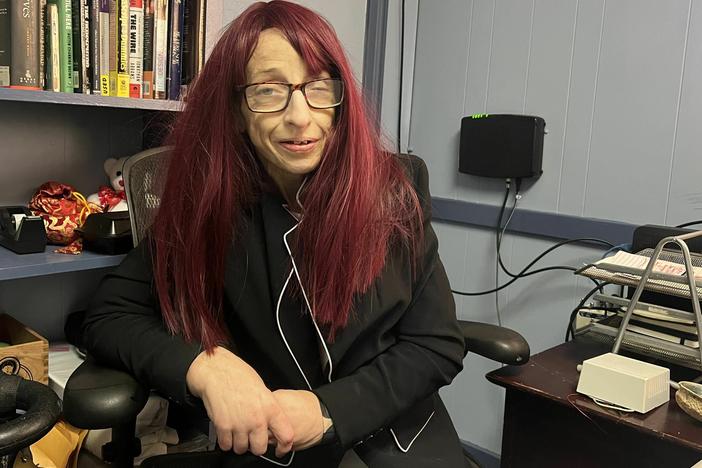Section Branding
Header Content
At Least 231 People Have Died In Texas Jails And Prisons From COVID-19, Study Finds
Primary Content
A new report from the University of Texas at Austin found that nearly 75% of those who died did not have a life sentence. The study's lead researchers says the virus has had a "devastating toll."
Transcript
LULU GARCIA-NAVARRO, HOST:
Early on in the pandemic, COVID-19 raced through nursing homes like wildfire. It then quickly spread in prisons, where it's nearly impossible to social distance, where there are usually no masks and hand sanitizer and even soap can be hard to come by. One of the worst places to be, according to a new report, is a Texas prison. The state has the largest number of people behind bars, with more than 23,000 confirmed cases of the virus with 190 deaths. Another 27 who died were staff. The report's lead researcher, professor Michele Deitch, joins us now from Austin.
Welcome to the program.
MICHELE DEITCH: Thank you so much for having me, Lulu.
GARCIA-NAVARRO: There are a lot of disturbing numbers in this study. What stood out to you?
DEITCH: Well, I think the main takeaway from the whole report is just the devastating toll of COVID on the Texas prison system. Each statistic is more stunning than the one before it.
GARCIA-NAVARRO: Yeah. In one prison called the Duncan Unit, 6% of the prison's entire population died. What happened there?
DEITCH: Well, this is a facility that primarily has geriatric prisoners. So it's not surprise that they were a particularly vulnerable population. But yes, 6% of the entire prison population died from COVID in that facility.
GARCIA-NAVARRO: I should mention NPR reached out to the Texas Department of Criminal Justice last week for their response to the study, but we have not heard back. They say they have had an aggressive testing campaign, for example, the largest in the country.
DEITCH: They have, and that's been terrific. But our report was really not about what steps have been taken or have not been taken. It was really just trying to identify the scope of the problem. And you can't ignore the fact that there are 190 dead people in our prisons. Those are numbers that testing does not explain.
GARCIA-NAVARRO: Yeah. I mean, this is also a tragic situation for the prison guards, the chaplains and other staff. Can you talk about what's happened there?
DEITCH: Well, I think that the situation for staff is incredibly challenging. Texas is a place that has a very bad understaffing problem, and many staff have been required to work overtime and to be doing their extra shifts in other facilities, which creates not only a risk of exposure for those staff members, but also a risk of transfer of the virus from facility to facility.
GARCIA-NAVARRO: One of the great risks is that prison guards, chaplains and other staff - they then could spread COVID-19 from the prison itself out into the community.
DEITCH: That's absolutely right. One of the lessons of the pandemic is that there's no bright line between what's happening inside our prisons and jails and what's happening in the community. We have staff that go back and forth on a daily basis, and they are taking what they are exposed to in the community, bringing it into the facilities and vice versa.
GARCIA-NAVARRO: Early in the pandemic, states like New Jersey, Ohio had similar COVID death rates among incarcerated people as Texas, but their numbers have since gone down, while Texas has not seen that same reduction. What have other states done to get this under control?
DEITCH: Our numbers show that the numbers of deaths has gone down over time in these other states. Many states have taken steps to reduce the population of incarcerated people. Another possibility is that they've taken more aggressive measures to protect people inside through offering hand sanitizer and hygiene supplies, cleaning supplies, soap and masks, of course.
GARCIA-NAVARRO: And just briefly, you've studied incarceration for a long time. What kind of solutions do you suggest?
DEITCH: Well, I think that our numbers point to some obvious groups that need to be targeted. Again, the experts have all recommended reducing the populations. You need to get the most vulnerable people out of harm's way. Prisons are some of the most densely populated facilities that we have, and we need to be able to give people more space.
So our report looks at people who are parole-eligible. Fifty-eight percent of the people who died in prison were parole-eligible. Nine people died after they were approved for parole but while they were still waiting to be released. We could be looking at speeding up those releases. We also found that 80% of the people who died were over age 55. That's an age past most people's crime-prone years. So that seems like a very low risk to public safety to be targeting those individuals for release.
GARCIA-NAVARRO: That's Michele Deitch. She teaches at the Lyndon B. Johnson School of Public Affairs and the School of Law at the University of Texas at Austin.
Thank you very much.
DEITCH: Thank you. Transcript provided by NPR, Copyright NPR.
Bottom Content



